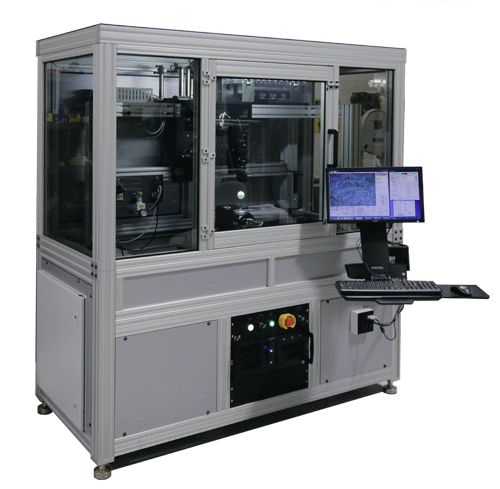Laser Micromachining
Our scientists have been involved in a number of very successful government and privately sponsored R&D efforts and are ready to investigate new approaches to laser applications in manufacturing.

Laser Micromachining - The Book
Table of Contents
Chapter 1: Introduction
Chapter 2: Laser Theory and Operation
2.1 Brief Review of Laser Physics
2.1.1 Quantum Theory of Light
2.1.2 Photon Interactions with Matter
2.1.3 Laser Physics and Population Inversion
2.1.4 Essential Elements of a Laser Oscillator
2.1.5 Important Characteristics of a Laser Beam
2.2 CO₂ Lasers
2.2.1 Characteristics of Carbon Dioxide Lasers
2.2.2 CO₂ Laser Operational Theory
2.2.3 Types of CO₂ Lasers
2.3 Solid State Nd³+ Lasers
2.3.1 Important Characteristics of Nd Lasers
2.3.2 Q-Switching
2.3.3 Nd:YLF vs. Nd:YAG vs. Nd:YVO₄
2.3.4 Harmonic Generation
2.4 Excimer Lasers
2.4.1 Excimer Laser Energy Transitions and Pump Scheme
2.4.2 Gas Discharge
2.4.3 Excimer Laser Energy Monitoring
2.4.4 Operation and Maintenance Costs
2.5 Fiber Lasers
2.6 Disk Lasers
2.7 Ultra Short Pulse (USP) Lasers
2.8 Comparison Between Laser Sources
Chapter 3: Optics
3.1 Optics
3.1.1 The Law of Refraction (Snell’s Law)
3.1.2 Simple Optics – Materials, Substrates, Coatings, Lenses and Prisms
3.1.3 Beam Splitters
3.1.4 Telescopes
3.1.5 Beam Profilometry
3.1.6 Homogenizers
3.1.7 Polarizers
3.2 Beam Delivery Systems – Imaging and Focusing
3.2.1 Focal Point Machining – Fixed Beam
3.2.2 Focal Point Machining – Galvanometers
3.2.3 Near-Field Imaging
3.2.4 Masks
3.2.5 Thin Lens Equation and Demagnification
3.2.6 Beam Compression
3.2.7 Beam Utilization Factor (BUF)
3.2.8 Beam Optimizing Considerations
3.2.9 Coordinated Opposing Motion Imaging
3.2.10 Direct-Write Machining
3.2.11 Contact Mask Processing
3.2.12 Multiple Laser Beams
3.3 Steps to an Effective Optical Setup
Chapter 4: Light - Material Interaction
4.1 Photoablation and Material Interaction with UV Light
4.2 Thermal Effects
4.3 Taper
4.4 Fluence
Chapter 5: System Integration
5.1 Processing System Considerations
5.2 General Requirements
5.3 Part Viewing Systems
5.3.1 Long Working Distance Optical Systems
5.3.2 Microscope Imaging Systems
5.4 Motion Control
5.4.1 Motors
5.4.2 Transmission Methods
5.4.3 Bearing Technology
5.4.4 Other Motion Elements
5.4.5 Power/Control Electronics
5.4.6 Controllers and Motion Software
5.5 Part Handling
5.6 Laser Support Systems
5.7 Software
5.8 Safety
5.8.1 Laser Safety
5.8.2 Mechanical Safety
5.8.3 Electrical Safety
5.8.4 Materials Safety
Chapter 6: Discussion of Some Processing Techniques
6.1 Aligning to Fiducials
6.2 Laser Drilling Large Numbers of Really Small, High-Aspect Ratio Holes
6.3 Gas Assist
6.4 Micromarking
6.5 Patterning Thin Films
6.6 Multiple Hole Drilling Using Galvos
6.7 In-Volume Selective Laser Etching (ISLE)
Chapter 7: Applications
7.1 Microelectronics and Semiconductors
7.1.1 Microvia Drilling
7.1.2 Dielectric Removal from Conductive Surfaces
7.1.3 Solder Mask Removal
7.1.4 Short Repair
7.1.5 Indium Tin Oxide and Conductive Metal Structuring
7.1.6 Wire Stripping
7.1.7 Resistor Trimming
7.1.8 Radio Frequency Identification
7.1.9Microelectromechanical Systems Components
7.2 Medical Devices
7.2.1 Diabetes Test Strips
7.2.2 Atomizers and Nebulizers – Drug Delivery
7.2.3 Microfluidics
7.2.4 Angioplasty and Stents
7.2.5 Catheters – Drug Delivery
7.2.6 Microfilters
7.2.7 Transdermal (Patch/Perforations)
7.2.8 Fluid Metering Devices – Orifices
7.2.9 Cutting Flat Sheet Stock
7.2.10 Three-Dimensional Surface Structuring
7.2.11 Marking
7.3 Defense Aerospace
7.3.1 Cutting and Drilling Composites – Carbon or Glass Fiber
7.3.2 Wire Stripping and Marking
7.3.3 Hole Drilling in Aircraft Engine Components
7.3.4 Removal of Thermal Barrier Coatings
7.3.5 Thin Film Processing (Large Panel Format)
7.4 Renewable Energy
7.4.1 Light-Emitting Diodes
7.4.2 Batteries
7.4.3 Microtexturing for Friction Reduction
7.4.4 Fuel Cells
7.4.5 Thin Film PV (Photovolaic)
7.4.6 Copper Indium Gallium Selenide
7.4.7 Edge Deletion
7.4.8 Emitter Wrap-Through and Metal Wrap-Through
7.4.9 Organic PV
7.5 Other
7.5.1 Automobiles
7.5.2 Ink-Jets
7.5.3 Cutting and Scoring Display Glass
Chapter 8: Materials
8.1 Metals
8.1.1 Stainless Steel
8.1.2 Copper
8.1.3 Molybdenum
8.1.4 Aluminum
8.1.5 Titanium
8.1.6 Nickel and Nitinol
8.1.7 Thin Metallic Films
8.2 Ceramics
8.2.1 Alumina
8.2.2 Silicon Carbide and Silicon Nitride
8.2.3 Zirconia
8.3 Glasses
8.4 Silicon and Gallium Arsenide
8.5 Polymers
8.5.1 Parylene™ - Poly (P-Xylylene) Polymers
8.5.2 Teflons™ - Polytetrafluoroethylene and Nylons™ (Polyamides)
8.5.3 Silicone
8.5.4 Kapton™ and Upilex™ (Polyimides)
8.5.5 Mylar™
8.6 Diamond
Chapter 9: Metrology and Cleaning
9.1 Metrology
9.2 Post Laser Cleaning
9.2.1 Physical Scrub
9.2.2 Chemical Bath
9.2.3 Electropolishing
9.2.4 Plasma Etch
9.2.5 Sacrificial Coatings
Chapter 10: Conclusion
Appendix: Additional Reading
Problems
Index

